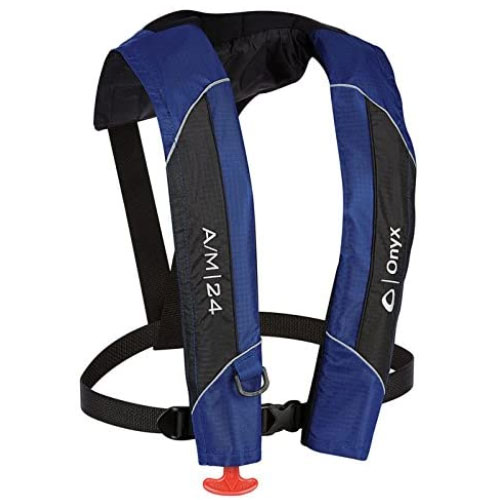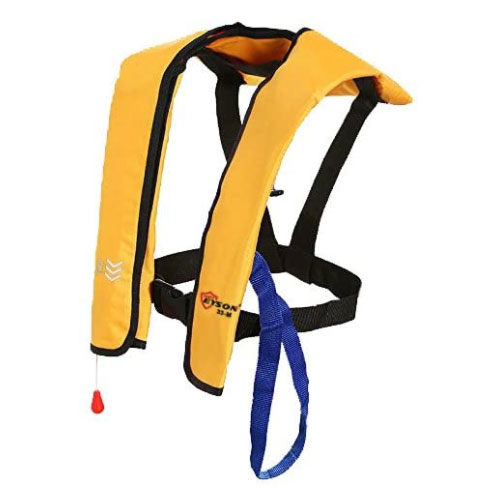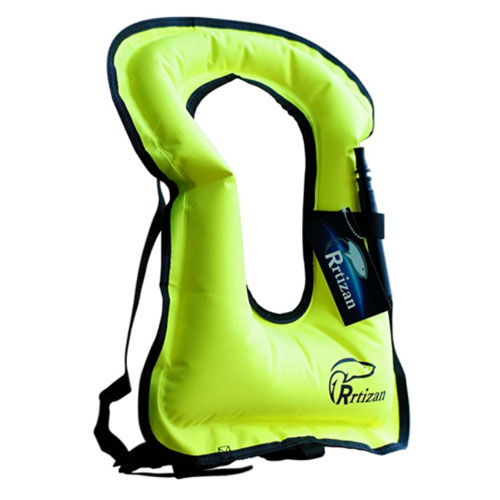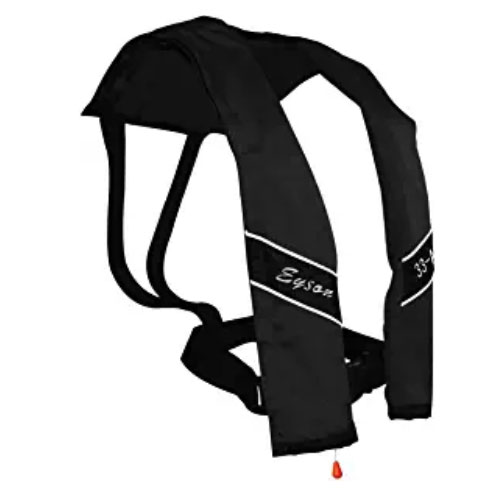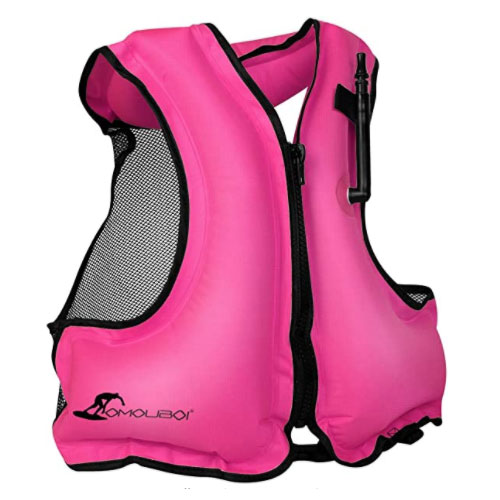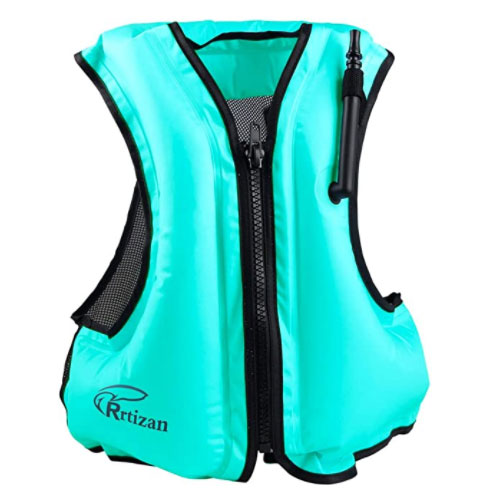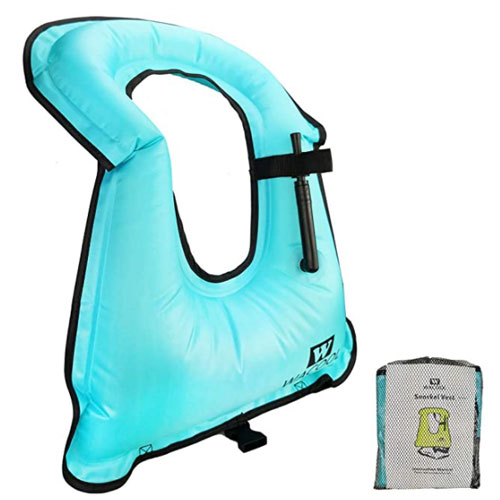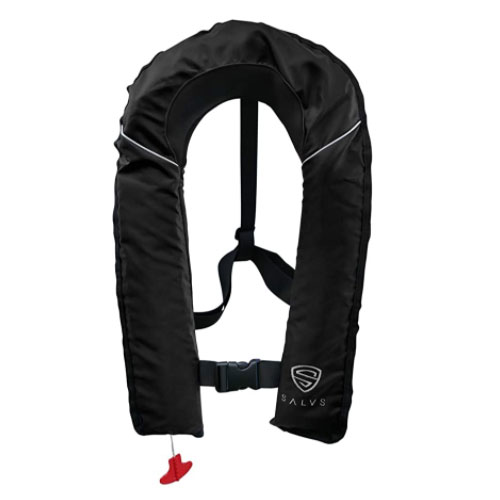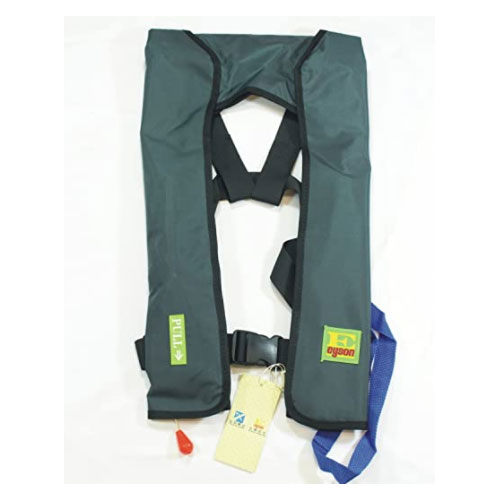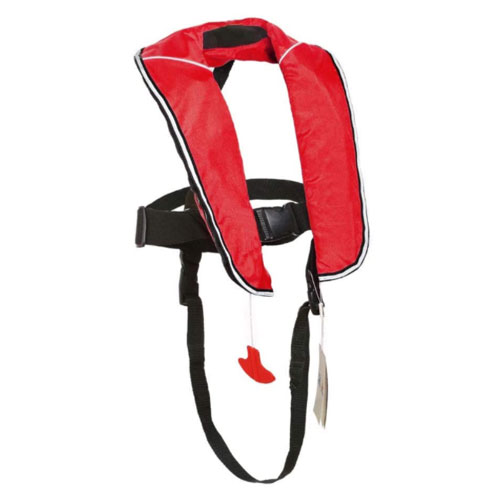
-
1.
-
2.
-
3.
-
4.
-
5.
When it comes to comfort and freedom of movement, the best inflatable life jacket beats a regular foam life vest hands down. As long as you’re a strong swimmer aged 16 years and above, you can enjoy maximum comfort and mobility without compromising safety by opting for an inflatable life jacket.
Finding the best inflatable life vest you can rely on to keep you safe requires paying attention to such things as ease of use and material quality. To help you find a good one, our inflatable life jacket reviews present the very best top rated inflatable life vests, while our buying guide offers tips on how to make the right choice.
OUR TOP PICK
Absolute Outdoor Onyx Automatic/Manual
- Stand Out Features - Why We Love It
- Coast Guard Approved Type V life jacket with Type III performance
- Inflates automatically upon immersion or manually with T-cord
- Convertible from automatic/manual inflation to manual only inflation
- Neoprene material around the neck provides all-day comfort
- Reflective piping enhances visibility in low light conditions
Best For: Kayaking, Boating, Fishing, Rafting
Coast Guard Approved: Yes
Size: Universal, Under 330lbs.
Material: Ripstop Nylon
EDITORS CHOICE
Eyson Automatic/Manual
- Stand Out Features - Why We Love It
- Manual and automatic options to choose between
- 3M reflective bands and emergency whistle included
- Back-up oral inflation tube included for extra security
- Rescue strap someone can use to pull you from the water
- Fabric cover and air bag sewed together for ease of use
Best For: Flatwater Paddling, Recreational Boating, Fishing
Approvals: CE
Size: Universal, Under 330lbs.
Materials: Cover: Polyester Oxford, Air Bag: Nylon + TPU
BEST VALUE
Rrtizan Unisex Adult Snorkeling Portable
- Stand Out Features - Why We Love It
- Lightweight, packable and easy to carry wherever you go
- Well-designed inflation valve makes inflation and deflation easy
- Bright hues provide excellent visibility in the water
- Adjustable waist and crotch straps provide a secure fit
Best For: Snorkeling, Free Diving, Swimming, Surfing
Coast Guard Approved: N/A
Size: Universal, 80-220lbs.
Materials: Canvas Outer, PVC Membrane
Eyson Slim Adult Automatic/Manual
- Stand Out Features - Why We Love It
- Transparent plastic window allows you to check device status
- Automatic and manual inflation and has backup oral inflation tube
- Stainless steel D-ring for attaching an item
- Soft neoprene neckline for all day comfort
- SOLAS Approved 3M reflective bands and emergency whistle
Best For: Flatwater Paddling, Recreational Boating
Approvals: CE
Size: Universal, Under 330lbs.
Materials: Cover: Polyester Oxford, Air Bag: Nylon + TPU
- Stand Out Features - Why We Love It
- Comfortable snorkel vest with a traditional vest design
- Open sides for mobility and mesh back for breathability
- Easy to inflate and deflate even when in the water
- High-visibility hue ensures visibility in the water
- Adjustable waist strap and leg straps for a secure fit
Best For: Snorkeling, Surfing, Paddling, Boating
Coast Guard Approved: N/A
Size: Universal, 80 to 220lbs.
Material: 60% Polyester and 40% PVC
WACOOL Portable Swimming Free Diving
- Stand Out Features - Why We Love It
- Available in kids and adults’ sizes, ideal for families
- Easy to inflate and deflate even for kids
- Lightweight and fold down small into the included mesh bag
- Adjustable waist strap and crotch strap ensure a secure fit
- Bright neon colors provide excellent visibility in the water
Best For: Snorkeling, Swimming, Boating, Fishing
Coast Guard Approved: N/A
Sizes: Kids and Adults, 80 to 220lbs.
Material: 60% Polyester + 40% PVC
Lifesaving Pro Premium Quality Automatic/Manual
- Stand Out Features - Why We Love It
- Automatically inflates upon immersion in water
- Also has manual inflation by pulling the inflation handle
- SOLAS approved reflective stripe for visibility when it’s dark.
- Soft neoprene neckline feels soft against the skin
Best For: Flatwater Paddling, Recreational Boating, Fishing
Approvals: CE Certification
Sizes: Universal, Under 330lbs.
Materials: Cover: Polyester and Neoprene, Airbag: Nylon + TPU
How To Choose An Inflatable Life Jacket – Buying Guide
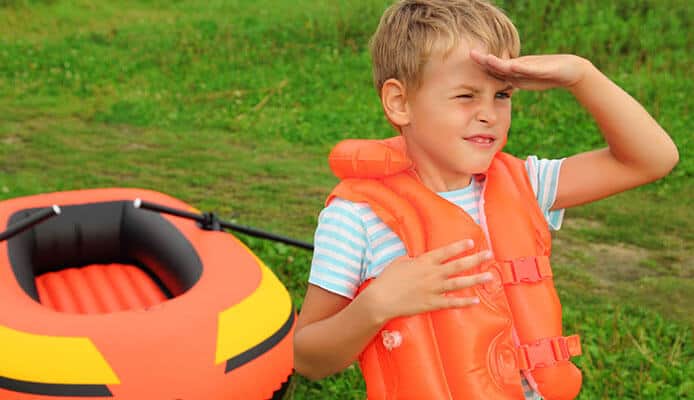
Type of activity
Of course, the best inflatable life jacket to go for will depend on the type of activity you want it for. For performance kayaking where the life jacket is bound to get wet, a manual PFD inflatable is ideal. Automatic life jackets are ideal for sailing and other types of boating activities. For swimming, free diving, and snorkeling, you will need a specially designed inflatable snorkel vest designed to help you float with your head in the water.
Related Reviews: Life Jacket For Canoeing & Wakeboard Life Jacket
Flotation
The inflated life jacket should provide adequate floatation in order to keep your head out of the water and your airways clear. The industry standard for these types of life jackets are 22 pounds of buoyancy, and this should be more than enough to keep you afloat. In rough seas, however, you will need an inflatable PFD with a minimum of 33 pounds of buoyancy lift.
Related Post: Life Jacket Buoyancy
Automatic or Manual inflate
While most inflating PFDs have both automatic and manual inflation, some are automatic inflation only or manual only inflatables. Which type of inflatable life vest is the right choice will depend on the activity. For sailing, boating, and paddling activities on calm waters, you can opt for a self inflating life jacket. Where you will have a lot of contact with water, manual only inflation is ideal, as it will prevent accidental inflation.
Harness
Having a harness gives you added peace of mind that it’ll be easier for the rescue team to pull you out of the water in the event of an emergency. Not a lot of life vests come with a built-in harness, but it’s a good idea to purchase one separately. The importance of having a harness increases the further away you are from the shore.
Comfort
Comfort is the hallmark of inflatable life vests. With their low profile design, they allow you a full range of motion and ensure you stay cool in hot conditions. To ensure the particular life vest you get will be comfortable, it’s important to choose one equipped with a soft neckline made of neoprene, and an adjustable belt for a custom fit.
You might also be interested in:
FAQs

Q: Are Inflatable Life Vests Safe?
Yes, inflatable life vests are safe for strong swimmers aged 16 years and above. Some of them are approved by the US Coast Guard while some boast CE certification.
Q: Are Inflatable Life Jackets USCG Approved?
Some inflatable life jackets are approved by the US Coast Guard while some are not. However, it’s important to note that the Coast Guard requires inflatable PFDs to be worn while underway.
Q: How Long Does An Inflatable Life Jacket Last?
Inflatable life vests have a ten-year lifespan. This is because they are made of tough materials that can resist tears and punctures, and the CO2 cylinders are replaceable. However, they require maintenance as often as every two to three months.
Q: Why Are Inflatable Life Jackets Not Recommended For Non Swimmers?
Inflatable life jackets are not recommended for non-swimmers or weak swimmers because they are not inherently buoyant. It takes several seconds before they can inflate and provide flotation. In the case of a manual inflatable life vest, the wearer has to pull the cord or blow air to inflate the jacket. For these reasons, inflatable life jackets are only approved for strong swimmers 16 years and older.
Q: How Often Should You Replace The CO2 Cylinder In An Inflatable PFD?
The CO2 cartridge should be replaced every time the inflatable PFD is activated. Without activation, each bobbin has a specified life span, which can be as long as three years. To be on the safe side, however, experts recommend replacing the bobbin and CO2 cartridge yearly, regardless of use.
Globo Surf Overview
An auto inflatable life vest is a great alternative to the traditional life jacket. A self inflating life jacket has a low profile design, but is much bigger than a foam life jacket when activated. This means that a CO2 life vest is much more comfortable to wear and also provides extra buoyancy in the water. Hopefully, this guide to inflatable PFD helps you find the best inflatable life jacket for your needs.
More Life Jacket By Age Reviews:
- Big And Tall Life Jackets
- Women’s Life Jackets
- Dog Life Jackets
- Life Jackets For Kids
- Infant Life Jackets
- Life Jackets


